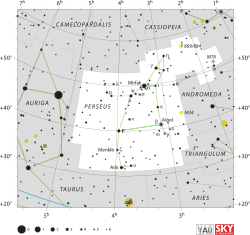Rho Persei

| |
| Observation data Epoch J2000 Equinox J2000 | |
|---|---|
| Constellation | Perseus |
| Right ascension | 03h 05m 10.59385s[1] |
| Declination | +38° 50′ 24.9943″[1] |
| Apparent magnitude (V) | +3.39[2] |
| Characteristics | |
| Spectral type | M4 II[3] |
| U−B color index | +1.79[2] |
| B−V color index | +1.65[2] |
| Variable type | Semiregular[3] |
| Astrometry | |
| Radial velocity (Rv) | +29.10 ± 0.30[4] km/s |
| Proper motion (μ) | RA: +129.22[1] mas/yr Dec.: –105.70[1] mas/yr |
| Parallax (π) | 10.60 ± 0.25[1] mas |
| Distance | 308 ± 7 ly (94 ± 2 pc) |
| Absolute magnitude (MV) | –1.7[5] |
| Details | |
| Mass | 5.0[6] M☉ |
| Radius | 150[6] R☉ |
| Luminosity | 2,290[6] L☉ |
| Surface gravity (log g) | 1.0[7] cgs |
| Temperature | 4,111[7] K |
| Rotational velocity (v sin i) | 11.2[7] km/s |
| Age | 4.4 × 108[8] years |
| Other designations | |
Rho Persei (Rho Per, ρ Persei, ρ Per) is a star in the northern constellation of Perseus. It has the traditional name Gorgonea Tertia,[10] being the third member of the quartet called the Gorgonea in reference to the Gorgons from the legend of Perseus.[8] An apparent visual magnitude of +3.39[2] makes it visible to the naked eye, but a challenge to view from a well-lit urban environment. Based upon parallax measurements, it is located at a distance of roughly 308 light-years (94 pc) from Earth.[1]
Rho Persei is a semiregular variable star of the μ Cephei type, whose apparent magnitude varies between 3.3 and 4.0[11] with periods of 50, 120 and 250 days.[5] The star has reached the asymptotic giant branch of its evolution. It is near the tip of the red giant branch with a stellar classification of M4 II.[3] The outer envelope has an effective temperature of 4,111 K,[7] giving it the red-orange hue of an M-type star.[12]
This star has a mass five times the mass of the Sun, while its radius has expanded to 150 times solar. It is radiating some 2,290 times the Sun's luminosity. Rho Persei is losing mass at the rate of 1.2 × 10−8 solar masses per year, or the equivalent of the Sun's mass every 83 million years.[6] It is about 440 million years in age.[8]
Naming
In Chinese, 大陵 (Dà Líng), meaning Mausoleum, refers to an asterism consisting of ρ Persei, 9 Persei, τ Persei, ι Persei, κ Persei, β Persei, 16 Persei and 12 Persei. Consequently, ρ Persei itself is known as 大陵六 (Dà Líng liù, English: the Sixth Star of Mausoleum.).[13]
References
- 1 2 3 4 5 6 van Leeuwen, F. (November 2007), "Validation of the new Hipparcos reduction", Astronomy and Astrophysics, 474 (2): 653–664, arXiv:0708.1752
 , Bibcode:2007A&A...474..653V, doi:10.1051/0004-6361:20078357
, Bibcode:2007A&A...474..653V, doi:10.1051/0004-6361:20078357 - 1 2 3 4 Nicolet, B. (1978), "Photoelectric photometric Catalogue of homogeneous measurements in the UBV System", Astronomy and Astrophysics Supplement Series, 34: 1–49, Bibcode:1978A&AS...34....1N
- 1 2 3 Ragland, S.; et al. (November 2006), "First Surface-resolved Results with the Infrared Optical Telescope Array Imaging Interferometer: Detection of Asymmetries in Asymptotic Giant Branch Stars", The Astrophysical Journal, 652 (1): 650–660, arXiv:astro-ph/0607156
 , Bibcode:2006ApJ...652..650R, doi:10.1086/507453
, Bibcode:2006ApJ...652..650R, doi:10.1086/507453 - ↑ Famaey, B.; et al. (May 2009), "Spectroscopic binaries among Hipparcos M giants. I. Data, orbits, and intrinsic variations", Astronomy and Astrophysics, 498 (2): 627–640, arXiv:0901.0934
 , Bibcode:2009A&A...498..627F, doi:10.1051/0004-6361/200810698
, Bibcode:2009A&A...498..627F, doi:10.1051/0004-6361/200810698 - 1 2 Yeşilyaprak, C.; Aslan, Z. (December 2004), "Period-luminosity relation for M-type semiregular variables from Hipparcos parallaxes", Monthly Notices of the Royal Astronomical Society, 355 (2): 601–607, Bibcode:2004MNRAS.355..601Y, doi:10.1111/j.1365-2966.2004.08344.x
- 1 2 3 4 Cox, Arthur N.; Becker, Stephen A.; Pesnell, W. Dean, "Chapter 20. Theoretical Stellar Evolution", Allen's astrophysical quantities (PDF) (4th ed.), New York: Springer, p. 516, ISBN 0-387-98746-0, retrieved 2012-01-25 See table 20.5
- 1 2 3 4 Massarotti, Alessandro; et al. (January 2008), "Rotational and Radial Velocities for a Sample of 761 HIPPARCOS Giants and the Role of Binarity", The Astronomical Journal, 135 (1): 209–231, Bibcode:2008AJ....135..209M, doi:10.1088/0004-6256/135/1/209
- 1 2 3 Kaler, James B., "GORGONEA TERTIA (Rho Persei)", Stars, University of Illinois, retrieved 2012-01-25
- ↑ "rho Per -- Semi-regular pulsating Star", SIMBAD, Centre de Données astronomiques de Strasbourg, retrieved 2012-01-24
- ↑ Allen, Richard Hinckley (1899), "Star-names and their meanings", New York, G. E. Stechert: 334, Bibcode:1899sntm.book.....A
- ↑ Kukarkin, B. V.; et al. (1971), "General Catalogue of Variable Stars", General Catalogue of Variable Stars (3rd ed.), Bibcode:1971GCVS3.C......0K
|contribution=ignored (help) - ↑ "The Colour of Stars", Australia Telescope, Outreach and Education, Commonwealth Scientific and Industrial Research Organisation, December 21, 2004, retrieved 2012-01-16
- ↑ (Chinese) AEEA (Activities of Exhibition and Education in Astronomy) 天文教育資訊網 2006 年 7 月 11 日